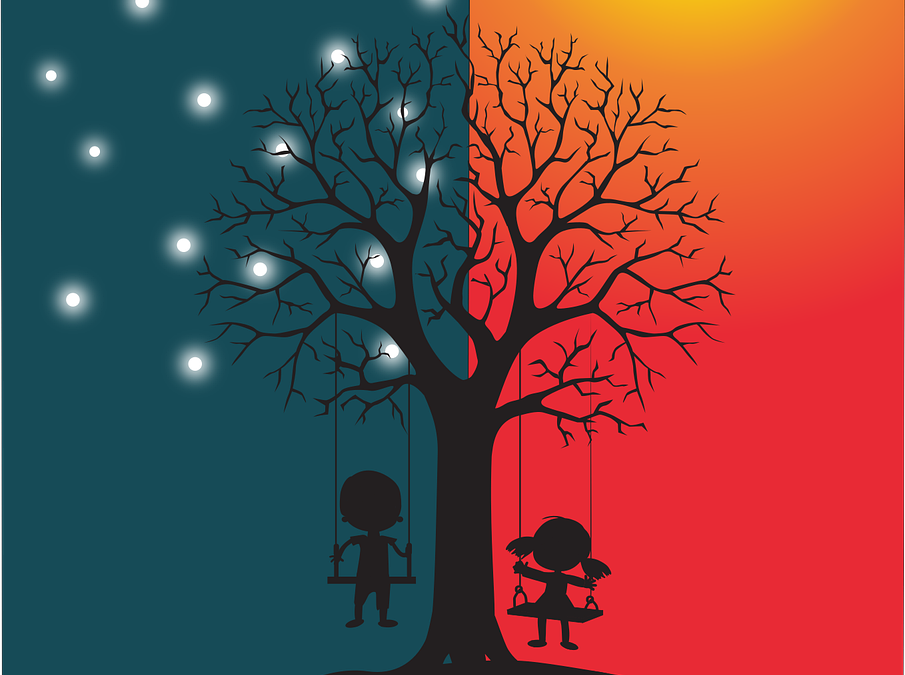Most of us approach parenthood with an idea of what kind of parent we hope to be. Usually, we look to our family of origin for our role models, taking what seemed to work for us and putting aside what we, as children, really didn’t like.
Sometimes, however, we look at our parenting and resolve to do a “better” job. As admirable as this is, it is sometimes misguided. Many of you have heard my story about this: after living a childhood marked by poverty, alcoholic neglect, sexual abuse, and domestic violence, I resolved to be a better parent than mine had been (not a tall order, obviously). For me, this meant that my child would never feel left to her own resources when she needed love and support. Imagine my chagrin when my daughter’s kindergarten teacher met me at the curb to tell me, “Mrs. Tompkins, she is the only child in her class that doesn’t know how to peel a banana.” Mortified, but, thankfully, reflective enough to realize the pendulum had swung a bit too far off center. With the feedback I was able to adjust some of my well intentioned “support” to better allow her to realize her own power. (This ability to reflect is found in a part of our brains called the cortex.) This anecdote may fall under the umbrella of “Hell is paved with good intentions”, from Samuel Johnson, but I like “Good intentions are not the whole story. You must also pay attention.”, from George Hammond. It’s the paying attention that matters.
My mistake was that I was not paying attention to what my daughter needed; I was only considering what I wanted to give. I’m so grateful that the teacher spoke up. I’m also grateful that I was secure enough to receive that feedback and do something with it, to pay attention, to think about what it meant for my daughter’s development. I love the quote from Maya Angelou, “Do the best you can until you know better. Then when you know better, do better.”
If I put this idea into the context of parenting a child with a trauma history, as so many of your children have, there is another factor to consider: your emotional response to your child’s behavior. I wasn’t peeling her banana because she demanded it; I was peeling it because I didn’t know what she needed from me developmentally and because I wanted to be “helpful”.
Because our children with trauma histories (infant neglect, physical or sexual abuse, etc.) spend so much time in a heightened state of fear (in one of the much more primitive, dumb parts of their brains called the brainstem, diencephalon, or limbic system) we tread on eggshells much of the time. We live with very unpredictable emotional beings. Our children have brains that are different than ours, assuming we don’t share similar trauma. Where we can face life’s challenges from a place of security and plenty of support, our children often freak out over the slightest test of their patience, the slightest offense, the slightest disappointment, or provocation. This happens because they don’t start from a place of peace; they start from a neurological place of fear or suspicion. Their world view is one of “You are not there to meet my needs; you are there to disappoint or hurt me in some way.” We may even have a version of this about the world of strangers but know our family and friends are on our side, but our children tend to assume that NO ONE is on their side, even us; even after 5 years in our kind company.
What this means is that we have to be sensitive to what our children need, and those needs may not be in line with their chronological age. We may need to bring experiences that seem more suitable for an infant: rocking, singing, walking, car rides, swinging, etc., because these, and other more age appropriate, rhythmic activities, are profoundly regulating (think calming) for a child amped up or shut down by their long ago trauma. This may require that we re-think our definition of discipline. We have to give up the idea that we mustn’t reinforce negative behavior (reward the bad stuff). Our priority becomes regulation and if that happens to be fun, so be it. In fact, fun in the service of self-regulation is the icing on the cake!
This needs to happen routinely, briefly, many times a day, at home, at school, anywhere that might present a threat (and everything presents a threat). We need to build it into our days. Then, when things get out of control, we can employ a familiar, proven regulating break. Go for a walk, swing on the swings, use crayons or colored pencils, chop vegetables. Find rhythmic activities to do side by side together. No talking, no face to face time yet, just finding that rhythm until the feeling of safety returns. Then maybe, just maybe, they’ll be able to hear what we have to say. And if they get dysregulated in the conversation, we just go back to the rhythmic stuff. Maybe even spare the talking altogether as we would with a 3 year old. The 3 year old doesn’t need to understand, they just need to chill out.
Unfortunately, too often our children know exactly which buttons to push to get us to join them on the emotional roller coaster ride that is their day. This emotional chaos is familiar territory for them; peace and quiet can feel like the calm before the storm and it is so much better to know when the storm is coming (because they sure know how to provoke it) than to sit with the anxiety of wondering when it will descend upon them. These are the moments when keeping our cool, protecting our regulation, gets really challenging.
The skills we learned in the schoolyard to protect ourselves from bullies or with our smarty pants siblings can come roaring in. But just because this is what we want to give, it probably isn’t what our kids need from us. In another context, grown up to grown up, or kid to kid, it might be called for but here, we really need to keep our cool so we can think straight. Why? Because once regulated, together, we can enjoy a too-brief moment of safety and true connection, fleeting maybe, but real. Enough of those moments of connection, and the world gets a bit less scary, a bit less lonely for our children.
If you’ve read many of my blogs you know exactly what I’m about to say: How do we maintain or restore our own cool? Take a break, take a breath, take a walk, say a prayer, count to 10… whatever trick floats our particular boat, that’s what. I want us all to be free to bring our best self to the challenge of helping our children’s brains heal from trauma. Our temper, our frustration, our clenched teeth, our snarky comebacks aren’t what get us there; our calm persistence in the face of our own extreme frustration, hurt, fatigue, and provocation, allows us to employ the regulating, rhythmic practices that make a difference in our children’s ability to tolerate stress without a meltdown.
We don’t have to be perfect. We just have to have the tools handy (think rhythmic activities) to recover when we get cranky or out of sorts. Access to these tools (and our cortexes where we can find them) comes easier when we are taking time for ourselves regularly: time with friends, time for our spiritual needs, time doing the things that bring us peace (think hobbies), daily exercise, plenty of vegetables, and good sleep.
NEWS
- Check out the AZAFAP Event Calendar at https://azafap.gnosishosting.net/Events/Calendar.
- Our Friday night Happy Hour and Tuesday afternoon Coffee Chat continue. We’ve also added Wednesday R&R at 10 AM. Some find the facilitator (me, Nancy, or Michelle) and a single other participant; others find a conversation among 4 to 6 people. The topics range from the silly to what hobbies have us in their grip to what life has thrown in our path. If you ever find yourself wanting a bit of grown-up conversation, consider joining us (check your email for the unchanging link).
- Parent Mentor Partners: AZAFAP has trained volunteer parents as mentors who are ready to help support foster, kinship, and adoptive parents through one-to-one conversations. Interested? Fill out the form at https://www.azafap.org/family-support-services/
- Caring for Caregivers, funded by a grant from Blue Cross/Blue Shield, offers counseling services to AZAFAP members who don’t have insurance to cover such services. Apply at https://www.azafap.org/family-support-services
- I encourage you to check out what Dr. Bruce Perry has to offer. Find his thoughts at https://youtu.be/uOsgDkeH52o?t=3 and at https://www.childtrauma.org/trauma-ptsd
Thanks for listening. Take care of yourself so you can be there reliably for others.
Peace,
Cathy (cathyt@azafap.org)


Recent Comments